
Amalia of Solms-Braunfels was Princess of Orange by marriage to Frederick Henry, Prince of Orange. She acted as the political adviser of her spouse during his reign, and acted as his de facto deputy and regent during his infirmity from 1640 to 1647. She also served as chair of the regency council during the minority of her grandson William III, Prince of Orange from 1650 until 1672.
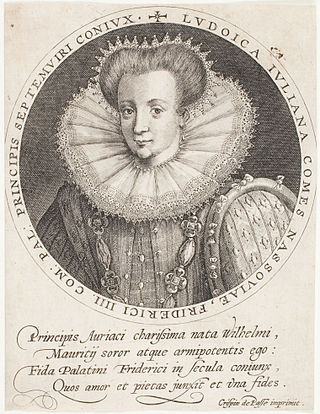
Louise Juliana of Orange-Nassau was a countess consort of the Palatinate by marriage to Frederick IV, Elector Palatine, and took part in the regency government of her son between 1610 and 1614. She also acted as a mediator between the king of Sweden and the elector of Brandenburg in 1631.
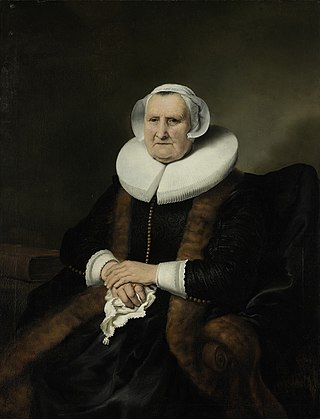
Elisabeth Bas was a Dutch businesswoman during the Republican era. She was the wife of Jochem Swartenhont.

Henriette Catherine of Nassau was princess consort of Anhalt-Dessau by marriage to John George II, Prince of Anhalt-Dessau, and regent of Anhalt-Dessau from 1693 to 1698 during the minority of her son Leopold I, Prince of Anhalt-Dessau.
Anna Maria de Bruyn was a leading Dutch stage actress and ballet dancer.
Susanna du Plessis (1739–1795) was a plantation owner in Dutch Surinam. She is a legendary figure in the history of Surinam, where she probably unjustly has become a metaphor of a cruel and sadistic slave owner. She is the subject of songs, plays, fairy tales and legends as well as books.

Princess Frederica Louise Wilhelmina of Orange-Nassau was a Hereditary Princess of Brunswick; married 14 October 1790 to Hereditary Prince Charles George August of Brunswick-Wolfenbüttel, son of Charles William Ferdinand, Duke of Brunswick-Wolfenbüttel. She was known in the family as "Loulou".
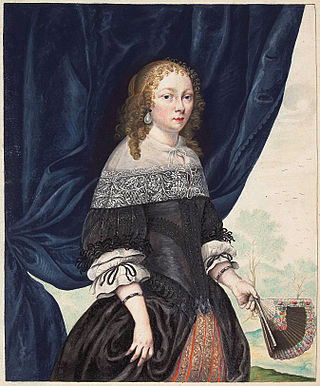
Gesina ter Borch was a Dutch Golden Age watercolorist and draftswoman, whose work mostly consists of watercolor paintings in albums. Most of her work captured her observations of family life, current events, and fashionable people. In addition to the visual arts, Gesina wrote love poetry.

Jurjentje Aukes Rauwerda, later Jurrentje Weinthal, was a Dutch prostitute and procurer. She was famous among members of her profession in the contemporary Netherlands, and ran the largest brothel in Amsterdam, the Maison Weinthal.
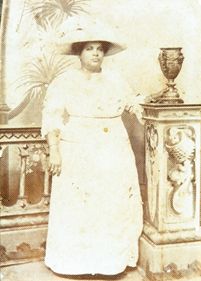
Augusta Cornelia Paulina Curiel (1873–1937) was a Surinamese photographer. She and her sister created an important record of life in the early twentieth century.
Catharina Johanna Koek (1763–1843), was a Dutch governor's wife. She is depicted in history as a typical example of the Dutch colonial customs in Dutch East Indies and how it was viewed by Europeans.
Cornelia van Lalaing, was a Dutch noblewoman, famous for the role she played in the so-called "Rennenberg Treason" in 1579 during the Eighty Year's War.
Marietje Jan de Gortersdochter was a Dutch Anabaptist. She is known in history as a martyr of the Anabaptist faith and the mother of the Anabaptist leader David Joris. She was married to the merchant Joris van Amersfoort. She was executed by decapitation in Delft after banned books had been found among her possessions.

Wilhelmina van Idsinga also Wilhelmina Geertruida of Idsinga, (1788–1819) was a Dutch painter. She was born in Leeuwarden.
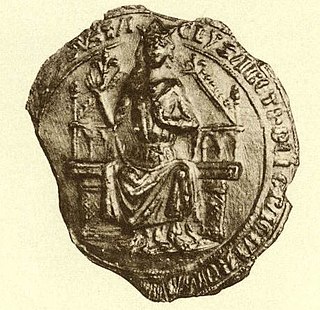
Elisabeth of Brunswick-Lüneburg was Queen of the Romans, Countess of Holland, and Countess of Zeeland as the wife of William II of Holland.

Jacoba Rauwerda (1835–1919) was a Dutch brothel manager. She was the owner and manager of the most famous brothel in 19th-century Amsterdam, the Maison Weinthal, between 1877 and 1902.

Elizabeth Sara Clasina de Swart, whose chosen name was 'Saar' de Swart, was a sculptor born to the Dutch painter Corstianus Hendrikus de Swart and his wife, Elisabeth Sara IJntema in Arnhem, Netherlands.
Catharina Petit (1660–1740) was a Dutch stage actress.
Machteld Aelbrechtsdr van Wouw (1580-1662) was a Dutch printer and publisher. She was the official state national publisher of the Dutch Republic between 1622 and 1662, with a monopoly on all government publications. She inherited the office from her late spouse Hillebrant Jacobsz. van Wouw (1577-1622), who in turn had inherited from her father Aelbrecht Hendricksz. van Leuningen (1545-1613).
Eiske ten Bos-Harkema was a Dutch politician.












